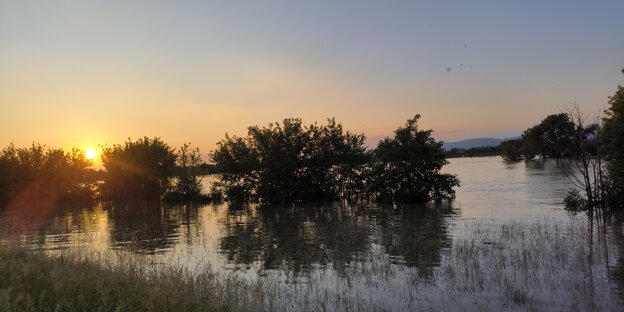In Hamburg, people are currently left out in the cold. But what if the brother lives in Straubing, Bavaria, on the Danube? A report from far away.
Menacingly beautiful: the Danube dam near Straubing on June 5 Photo: Lisa Gilch
It starts with the interactive flood map of the app “Tagesschau”. This map is difficult to use on a mobile phone because you have to hit the small round dots so precisely with your sausage fingers. Orange dots mean “moderate flooding,” red dots mean “major flooding,” purple dots mean “very major flooding.” Where I live, in Hamburg, it makes no sense. Where my brother lives, in Straubing, the dot is orange. It’s June 1st. Straubing is located in Lower Bavaria on the Danube between Regensburg and Passau.
It’ll be fine, I think. On the other side: The Danube flows in a curve around my brother’s house. It feels as if the house is in a depression, because the Danube is blocked by an earthen wall. If the water were to flow over the wall, the depression would fill up like a bathtub. The water would come from different directions. Anyway: “Middle-high water”, easy. It’s not the first time. It already happened when I was a child and lived in Regensburg.
It’s just stupid that the weather forecast says: Continuous rain in southern Germany this weekend. It also sucks that videos are constantly going live with the interactive flood map from the flood area come. And that there is now a live blog, such as about the wars in Ukraine and the Middle East.
The live blog of June 2 states: “Dam broken in the Pfaffenhofen district”, it is about the Paar River, a tributary of the Danube. Never heard. Then it says: “Disaster in now 12 districts.” I read on. ‘Disaster event’ means that any measures can be taken more quickly. A bureaucratic category, so to speak. Such as the ‘health emergency of international concern’ during the pandemic.
Pointless sandbags
If Straubing also reports a disaster, I pick up the phone. “So, have you drowned yet?” – “No, no,” says my brother. “Everything’s fine. The peak won’t come until this afternoon.” – “Okay, and will the dike hold up?” – “The dike? You mean the dam. After the big flood in 2013 they wanted to strengthen it. I hope they did it.” There was no trace of excitement.
Funny, I think. In Hamburg it is called “Deich” and in Straubing “Damm”. Apparently it’s something like the rolls called rolls in the south.
‘And what if the Danube floods there?’ – ‘You mean, what if the dam breaks? That would be stupid. That happened in 2013 thirty kilometers away in Deggendorf. But never with us.”
Three days later the peak wave should have been over long ago, another call to Straubing. It’s June 5. “Did you make it?” ‘Well,’ says my brother, ‘the dam has held, the top has been reached, but the water does not subside. The question is whether this will weaken the dam in the long term.”
And now? “You don’t notice the problem in the city. Everyone pats themselves on the back and says, “It’s okay. It also held up in 2013.’” And do you have sandbags on hand in case the dam breaks? “No, sandbags wouldn’t help. The fire brigade monitors the dam. That’s all.” And if it rains again at the weekend? “Hard to say. But so far “No rain is forecast.”
It’s a strangely ambivalent threat, the threat from beyond the dam. “The landscape is suddenly very different. It looks very beautiful especially in the evening. You think: the world ends in beauty.”
Nothing has been decided yet in Straubing. From Thursday afternoon.
